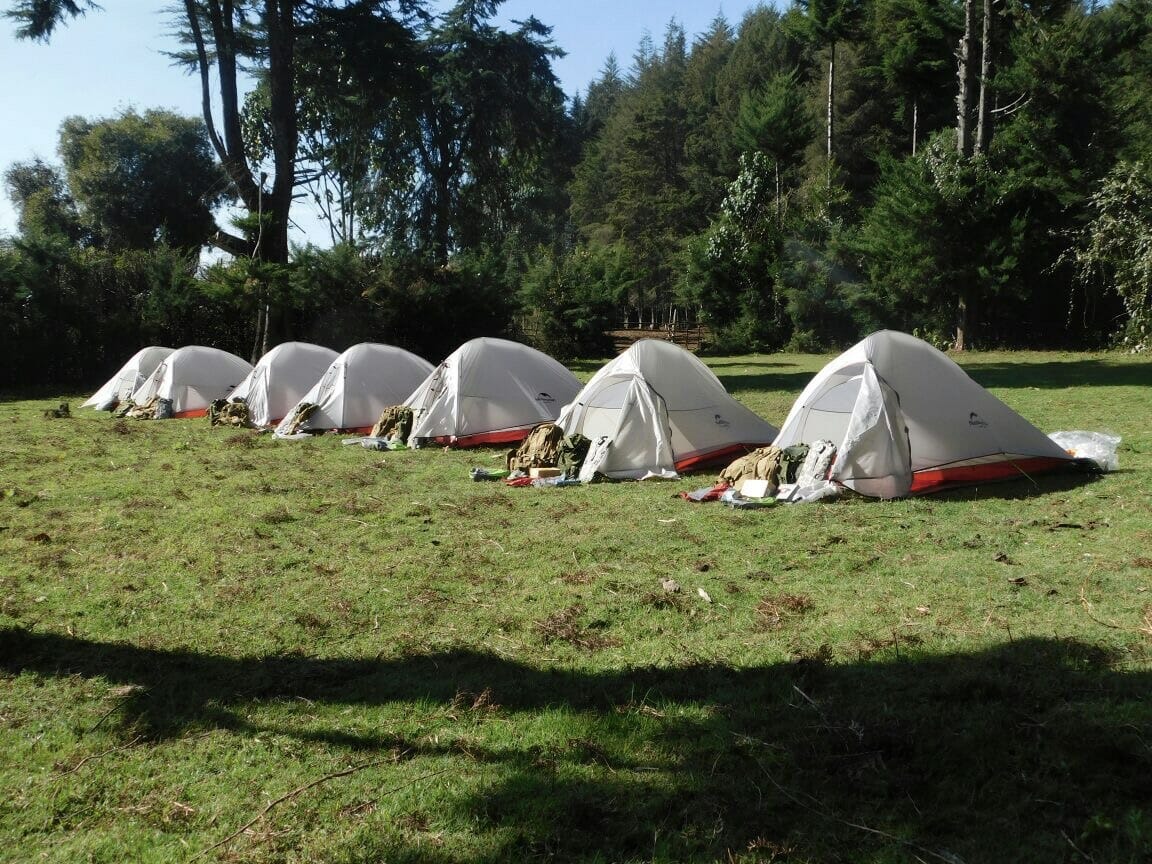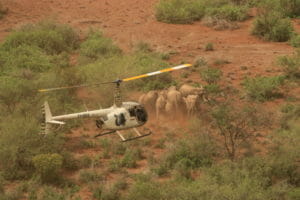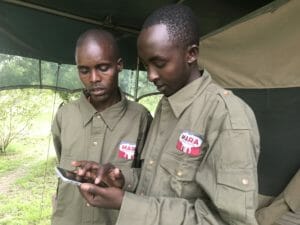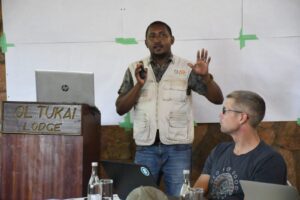The first quarter of 2018 for MEP rangers was focused on human-elephant conflict mitigation, intelligence gathering and monitoring elephants, as always, but during our routine activities we also focused the last three months on collecting better data and finding more efficient ways of reporting it.
In January, the David Sheldrick Wildlife Trust (DSWT) Mau De-Snaring Team was off and running protecting the estimated 600 elephants living in the Mau Forest. They received their camping supplies, uniforms, mobile solar power systems and other essentials. Already they have had successes in shutting down illegal logging sites, removing harmful snares and collecting important intelligence to root out poachers in the forest.
The DSWT Mau Forest team’s tents set up at the Kenya Forestry Service station on the edge of the forest.

As the C.E.O. Report mentioned, MEP rangers through intelligence collection recovered 95 kg of ivory (some pictured left) in the first quarter alone. MEP’s intelligence team along with the team leader went with the C.E.O. to Tanzania to meet with the Singita Grumeti Fund’s ranger team to share our findings from the Mara ecosystem. It was a great opportunity for our two intelligence heads to meet and exchange information. This will be a partnership that we hope will significantly decrease the amount of ivory being poached in Tanzania and coming into Kenya.
In March, the intelligence team received two new Honda motorbikes for their undercover work and, with the generous support of a donor, we are going to purchase a dedicated intelligence team vehicle in April. All of this combined with new partnerships will enable us to expand our intelligence network even further.
 In January, MEP rangers have experienced an increase in human-elephant conflict from eight incidents in December 2017 to 30 incidents in January 2018. The Olopikidongoe team responded to 25 conflict incidents alone. MEP rangers were busy in the Transmara responding to conflict which is a reflection of the ripening maize farms. They chased elephants out of farms nearly every night and large herds of elephants have been seen coming out of the Nyakweri Forest. Our rangers have been working hard to make sure we record zero elephant deaths related to conflict. In February, the conflict reduced but was back up again in March with 16 conflict incidents reported in the Transmara. We expect these numbers to jump in April and May as planting has begun in Munyas and the Transmara and the rains have been plentiful.
In January, MEP rangers have experienced an increase in human-elephant conflict from eight incidents in December 2017 to 30 incidents in January 2018. The Olopikidongoe team responded to 25 conflict incidents alone. MEP rangers were busy in the Transmara responding to conflict which is a reflection of the ripening maize farms. They chased elephants out of farms nearly every night and large herds of elephants have been seen coming out of the Nyakweri Forest. Our rangers have been working hard to make sure we record zero elephant deaths related to conflict. In February, the conflict reduced but was back up again in March with 16 conflict incidents reported in the Transmara. We expect these numbers to jump in April and May as planting has begun in Munyas and the Transmara and the rains have been plentiful.
Some very exciting news from the first quarter of 2018, MEP rangers deployed a new human-elephant mitigation tool called solar powered flashing lights. These lights can be charged while in the field and provide a bright flashing light that is a deterrent for elephants. We mount the lights onto poles around farms and have found they are more cost effective and sustainable than chili fences. We experimented with a large farm in the Olopikidongoe area, one of the worst conflict sites, and the lights worked very well and the decrease in conflict in the area can be attributed to the fence.

Solar powered flashing light fences being installed.
We continue to work towards collecting better data using more efficient methods. It is crucial that MEP is able to build our evidence base to inform local policy and spatial planning.
 Rangers have been filling out new MEP human-elephant conflict forms and mitigation forms starting in the first quarter of 2018. The data collected on these forms differs slightly. The human-elephant conflict forms are filled out to detail the information on the conflict incident. Data points like date, time, location, number of elephants, crop types, etc. can all be collected to give MEP a big picture of human-elephant conflict seasons and reasons. The mitigation forms are for reporting crop loss and structural damage to farms or villages. On these forms we collect the names of anyone hurt, property damaged, acreage lost, etc. We then bring all of this data back to MEP HQ and input it into the Domain Awareness System (DAS).
Rangers have been filling out new MEP human-elephant conflict forms and mitigation forms starting in the first quarter of 2018. The data collected on these forms differs slightly. The human-elephant conflict forms are filled out to detail the information on the conflict incident. Data points like date, time, location, number of elephants, crop types, etc. can all be collected to give MEP a big picture of human-elephant conflict seasons and reasons. The mitigation forms are for reporting crop loss and structural damage to farms or villages. On these forms we collect the names of anyone hurt, property damaged, acreage lost, etc. We then bring all of this data back to MEP HQ and input it into the Domain Awareness System (DAS).
MEP rangers also acquired four Garmin in-reach devices in February. These devices send location points every two minutes via satellite to MEP HQ via DAS. They also give us real time data of ranger positions and allow rangers to send 40 free messages per month and unlimited pre-set messages. All MEP rangers received training at MEP HQ on how to use the devices and the Olkinyei team, Transmara team, Mau team and the mobile team have each been issued their own. MEP rangers have moved away from using the WILD app and are relying more on the Garmin In-Reach devices for their data collection.

MEP ranger movements as recorded in January.
It’ll be a busy second quarter in the Mara, but with your support, MEP rangers will continue to protect elephants in the greater Mara ecosystem.


